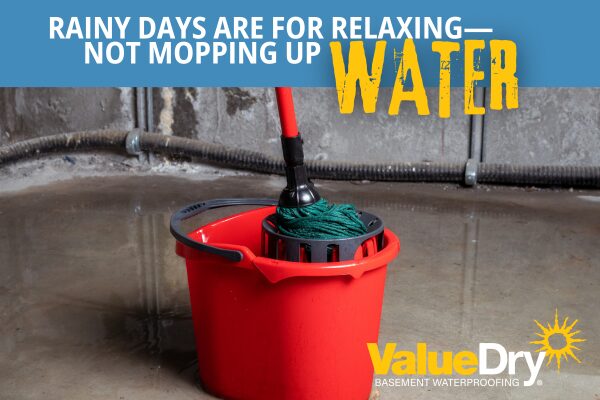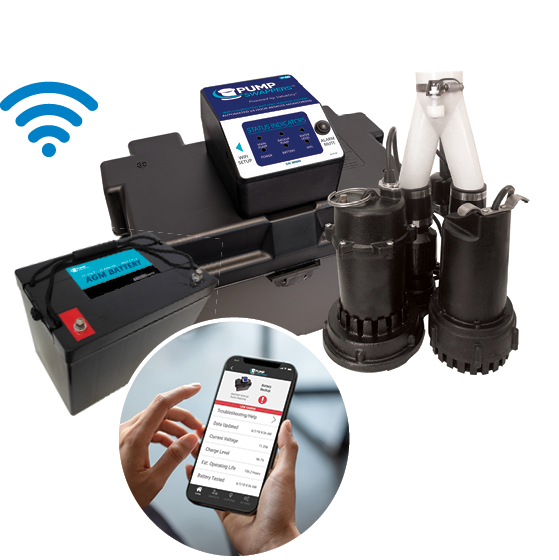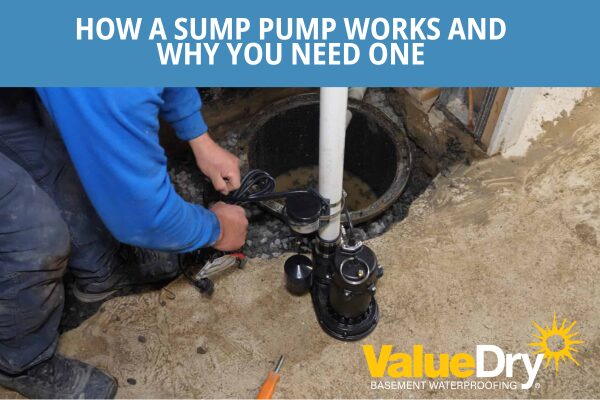How a Sump Pump Works and Why You Need One
- May 2, 2025
- No Comments
Understanding Your Home’s First Line of Defense: How a Sump Pump Works and Why You Need One
When it rains, your roof and gutters aren’t the only lines of defense protecting your home. What happens below your feet—in your basement or crawl space—can have just as much impact on the safety, health, and value of your home.
Enter the sump pump: the often-overlooked hero of home waterproofing systems. If you’ve ever wondered what a sump pump does, when it kicks into gear, or why a battery backup system is so important, you’re in the right place.
In this guide, we’ll walk you through everything you need to know about sump pumps—how they work, why they matter, and what you can do to ensure yours is always ready when the water starts rising.
What Is a Sump Pump?
A sump pump is a water-removal device installed in the lowest part of a basement or crawl space. Its job? To collect and pump out water that would otherwise cause flooding, moisture buildup, and structural damage.
It sits in a specially constructed pit—called a sump basin—and waits. When water levels rise during a storm, snowmelt, or plumbing leak, the pump automatically activates and channels the water away from your foundation, usually toward a storm drain or dry well.
In short, it’s your home’s emergency drainage system—designed to protect your basement before flooding happens.
How Does a Sump Pump Work?
The Key Components of a Sump Pump System
A typical sump pump system includes:
- Sump basin – A pit dug into the floor of your basement or crawl space where water naturally collects
- Float switch – A sensor that rises with the water level and activates the pump
- Pump unit – The actual mechanism that pulls in water and pumps it away
- Discharge pipe – A pipe that carries water out and away from your home’s foundation
- Check valve – Prevents water from flowing back into the pit after being pumped out
The Activation Process
When water accumulates in the sump basin, it causes the float switch to rise. Once the float hits a certain level, it triggers the pump to turn on. The pump then sucks in the excess water and pushes it through the discharge pipe, safely moving it away from your home’s structure.
As soon as the water level drops, the float switch returns to its resting position, and the pump shuts off. This cycle may repeat several times during a storm—or stay quiet for weeks when it’s dry.
When Does a Sump Pump Kick In?
Sump pumps are designed to activate automatically whenever water collects in the basin. This can happen:
- During heavy rainstorms or hurricanes
- When snow melts quickly
- Due to a high water table in your region
- If you experience foundation cracks or seepage
- During plumbing malfunctions or leaks
If your pump is in good working condition, you may not even realize it’s doing its job—until it isn’t.
Why Every Home Needs a Sump Pump
Whether you live in a flood-prone area or not, a sump pump is one of the smartest investments a homeowner can make. Here’s why:
1. Prevents Basement Flooding
The most obvious benefit is keeping your basement dry. Even small amounts of flooding can ruin furniture, electronics, personal belongings, and insulation.
2. Stops Mold and Mildew Before It Starts
Mold thrives in damp, dark environments. A wet basement becomes a breeding ground for harmful spores, which can spread through your HVAC system and affect indoor air quality.
Learn more about mold and air quality in our blog: “What’s Lurking in Your Basement Air?”
3. Protects Structural Integrity
Constant moisture can cause wood rot, rust, and foundation cracks—all of which can compromise your home’s stability.
4. Boosts Property Value
Having a professionally installed sump pump (especially with a battery backup) can be a major selling point for potential buyers and real estate agents.
Check out our tips for real estate pros: “Basements That Sell: What Real Estate Agents Should Know”
5. Offers Peace of Mind During Every Storm
Knowing your basement is protected lets you focus on enjoying the sound of rain rather than rushing for towels and a wet vac.

The Problem with Power Outages: Why a Battery Backup Matters
Sump pumps are powered by electricity—which becomes a problem during power outages, especially when heavy rains and storms knock out your supply.
That’s where a battery backup system comes in.
What Is a Sump Pump Battery Backup?
A battery backup is a secondary power source for your sump pump. It kicks in automatically if the main power goes out or if the primary pump fails. That way, even in the worst weather, your basement stays dry.
Many backup systems also include an alarm system that notifies you when the backup is running—so you’re never caught off guard.
When Should You Upgrade or Replace Your Sump Pump?
Sump pumps don’t last forever. On average, a sump pump has a lifespan of 7 to 10 years, depending on the quality of installation, maintenance, and usage.
Signs It’s Time for a Replacement or Upgrade:
- The pump is constantly running, even when it’s not raining
- You hear strange noises like grinding, rattling, or humming
- There’s a musty smell in the basement that won’t go away
- You’ve experienced minor water damage even with a pump installed
- Your home doesn’t currently have a battery backup system
Need help evaluating your system? Schedule a free inspection with Value Dry and we’ll take a look.
Why Trust the Pros at Value Dry?
At Value Dry Waterproofing, we’ve been helping homeowners across the region protect their homes for over 20 years. Our team of certified professionals will evaluate your basement, recommend the right solution, and install everything with efficiency and care.
We handle:
- Full perimeter drainage systems
- Interior French drains
- Sump pump installations and replacements
- Battery backup systems
- Crawl space encapsulation
- Foundation sealing
All of our work is backed by industry-leading warranties and a commitment to your long-term comfort and safety.
May Special: Get More Protection for Less
For a limited time, we’re offering:
- Free Financing Options
- A Free Battery Backup System with the purchase of a full perimeter waterproofing solution
Protect your home this spring—before the next storm strikes.
Click here to schedule your FREE inspection today
No pressure. No obligation. Just expert advice and real peace of mind.

FAQs About Sump Pumps
Q: Do all homes need a sump pump?
A: If your home has a basement or crawl space and you’re in an area with rainfall or groundwater issues, a sump pump is a smart choice. It’s not just about flooding—it’s about controlling humidity and long-term damage.
Q: Can I install one myself?
A: While some homeowners may attempt DIY installs, sump pumps are best left to professionals. An improperly installed system can lead to backups, inefficiency, and voided warranties.
Q: How often should I test my sump pump?
A: At least once every season. Simply pour a bucket of water into the basin and make sure the pump activates properly. If you’re unsure, schedule an inspection with us and we’ll test it for you.
Related Articles You Might Like:
- “Spring Showers Shouldn’t Mean Basement Floods”
- “Do You Really Need a Battery Backup for Your Sump Pump?”
- “How to Keep Mold Out of Your Crawl Space Year-Round”
- Visit Our Services Page for More Waterproofing Solutions
Don’t Wait for the Water to Rise
Whether you’ve got a finished basement, a storage space full of memories, or simply want to protect your home’s foundation, a working sump pump is your best line of defense.
Add in a battery backup, and you’re storm-ready—no matter what Mother Nature throws your way.
Let’s keep your basement dry and your mind at ease.
Schedule your free inspection today or call us to learn more about our full perimeter waterproofing systems.
We’ll take care of the water—so you can get back to relaxing.


